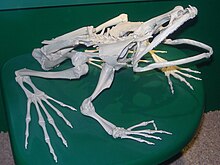Goliath frog
| Goliath frog | ||||||||||||
|---|---|---|---|---|---|---|---|---|---|---|---|---|

Goliath frog ( Conraua goliath ); Specimen / model in the American Museum of Natural History |
||||||||||||
| Systematics | ||||||||||||
|
||||||||||||
| Scientific name | ||||||||||||
| Conraua goliath | ||||||||||||
| ( Boulenger , 1906) |
The goliath frog ( Conraua goliath , Syn . : Rana goliath , Gigantorana goliath ) is a frog that occurs in West Africa . The genus Conraua comprises a total of six species. For this genus a separate monogeneric family called Conrauidae was established.
With a presumed maximum head-torso length of around 40 centimeters - scientifically documented so far are 32 and 33 centimeters - Conraua goliath is the largest recent frog in the world. Such specimens weigh well over three kilograms. Figures from 60 to 80 centimeters in height include the outstretched rear legs. In zoology , however, this type of measurement is not common for four-legged friends. The head-trunk length is measured in frogs from the tip of the snout to the cloaca .
features
Goliath frogs have a relatively pointed snout and extremely strong, long hind legs. In adult animals, the thighs reach the thickness of a human wrist. The webbed toes extend to the tips of the toes. The pupils of the eyes are set horizontally; the outer eardrums are comparatively very small with half a centimeter in diameter. A skin fold runs over each of these along the back of the head. While the skin on the top is somewhat wrinkled and granulated and has an inconspicuous, green-brownish color, the belly and the insides of the limbs are smoother and often yellow-orange in color.
distribution
The distribution area of this species includes the West African countries Cameroon and Equatorial Guinea and extends from the lower reaches of the Sanaga River in the north to the lower Benito River valley in the south. In between, this area occupies a width of around 150 to 180 kilometers along the Atlantic coast . It is therefore a very small occurrence area that is also not populated across the board and evenly, but only disjoint .
Habitat, way of life
Larger, fast-flowing watercourses in the middle of the tropical rainforest serve as habitat . Goliath frogs mainly live near and in water ( aquatic ) and need clean, oxygen-rich water and a sandy bottom. The tadpoles are in the first few weeks to a particular aquatic plant ( Leiothylax warmingii , Syn .: Dicraea warmingii warmingii family podostemaceae instructed as a food source), which grows on rocks below waterfalls and the river. Their larval phase lasts about 85 to 95 days until metamorphosis . Previously, they developed from spawning clumps of several hundred eggs each, which the adult goliath frogs laid on aquatic plants at the bottom of the river in July and August.
The goliath frog is sometimes characterized as a "bad jumper", but on the other hand huge jumps of up to three (five) meters should be observed. However, the animal will probably tire after a few sentences. In case of danger, the frog either tries to dive down and hide in deep river holes or it pretends to be dead to the attacker. Its food spectrum includes live animal food, which it can overwhelm in size and devour whole. In addition to insects, this can also be, for example, smaller reptiles and young water birds.
Danger
The IUCN has recently categorized the goliath frog not only as "vulnerable" (endangered), but as "endangered" (highly endangered). The causes are habitat destruction and pollution (especially the conversion of rainforest to agricultural land) as well as hunting and trapping by humans. Goliath frogs are considered a delicacy and an important source of food for some people in the area. In the past, they were also caught in large numbers for zoos and the pet trade, where it turned out that the animals were difficult and unsuitable to keep and therefore generally did not reproduce in captivity. In terrariums , they often blew their muzzles when they jumped against the glass panes.
The small and fragmented natural range makes the stern animals particularly susceptible to external influences and negative environmental changes. The government of Cameroon is said to have limited the annual export of goliath frogs, particularly to US zoos, to 300 specimens.
Taxonomy and systematics
Some overviews place this taxon in the Petropedetidae family , others in a subfamily Petropedetinae within the real frogs (Ranidae).
Web links (partly sources)
- Wiktionary: Goliath frog - explanations of meanings, word origins, synonyms, translations
- Species portrait at Amphibiaweb.org (Engl .; partly source; with photo)
- IUCN Redlist: Entry on Conraua goliath (English; among other things with a larger distribution map)
- Goliath Frog wmv film (Engl .; BBC)
- Goliath frog images on Google Images (without guarantee of correctness - there are also incorrectly assigned images!)
- American Museum of Natural History: Amphibian Species of the World (Engl.)

